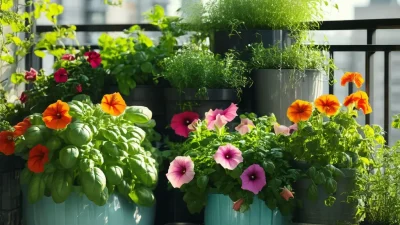The Ultimate Guide to Growing Herbs in Your Backyard
Gardening is more than just a hobby; it’s a way to connect with nature and enjoy the fruits of your labor. One of the most rewarding aspects of gardening is growing your own herbs. Not only do they add flavor to your meals, but they also bring a sense of accomplishment. In this guide, we’ll walk you through everything you need to know about growing herbs in your backyard.
Why Grow Herbs?
Herbs are versatile and can be used in cooking, teas, and even as natural remedies. They’re also low-maintenance compared to other plants, making them ideal for beginners. Plus, nothing beats the fresh aroma of herbs growing right outside your door.
Choosing the Right Herbs
Before you start planting, it’s essential to choose herbs that suit your climate and taste. Popular choices include:
- Basil: A must-have for Italian dishes
- Rosemary: Adds a fragrant touch to roasted meats
- Thyme: Perfect for seasoning vegetables
- Mint: Great for teas and cocktails
Consider your space as well. Some herbs, like parsley, are better suited to containers if you have limited garden space.
Preparing the Soil
Good soil is the foundation of a healthy herb garden. Ensure the soil is well-draining and rich in organic matter. You can improve your soil by adding compost or well-rotted manure. Test your soil pH to ensure it’s suitable for the herbs you’re growing.
Planting Your Herbs
Most herbs prefer full sun, so choose a spot that gets at least 6 hours of sunlight daily. When planting, space them appropriately to allow for growth. Here are some tips:
- Dig holes twice the size of the root ball
- Water thoroughly after planting
- Mulch around the base to retain moisture
Caring for Your Herbs
Regular care is essential for a thriving herb garden. Water your herbs deeply but allow the soil to dry slightly between watering sessions. Overwatering can lead to root rot. Additionally, pinch back the tips of your herbs to encourage bushier growth.
Pest Control
Herbs are generally resistant to pests, but keep an eye out for common garden pests like aphids and spider mites. Use natural pest control methods such as insecticidal soap or neem oil.
Harvesting Your Herbs
Knowing when to harvest is crucial for the best flavor. Most herbs are ready to harvest once they’ve grown several sets of leaves. Here’s how:
- Basil: Pick leaves as needed, but avoid harvesting more than a third at a time
- Thyme: Snip sprigs when you need them
- Rosemary:剪下新梢,留下足够的芽让植物继续生长
Preserving Your Harvest
If you have more herbs than you can use fresh, consider drying or freezing them. Drying is simple: just tie the stems in bunches and hang them in a cool, dark place. For freezing, chop the leaves and store them in ice cube trays with a bit of water.
Common Mistakes to Avoid
Even experienced gardeners make mistakes. Here are some to watch out for:
- Overwatering: Only water when the top inch of soil is dry
- Not enough sunlight: Ensure your herbs get plenty of sun
- Poor soil preparation: Invest time in creating a good growing environment
Conclusion
Growing herbs is a rewarding and easy way to add freshness to your meals. By following these simple steps, you’ll be well on your way to enjoying homegrown herbs all year round. Remember, the key to success is preparation, care, and patience.
For more tips, check out resources like the USDA or local gardening clubs. Happy gardening!





